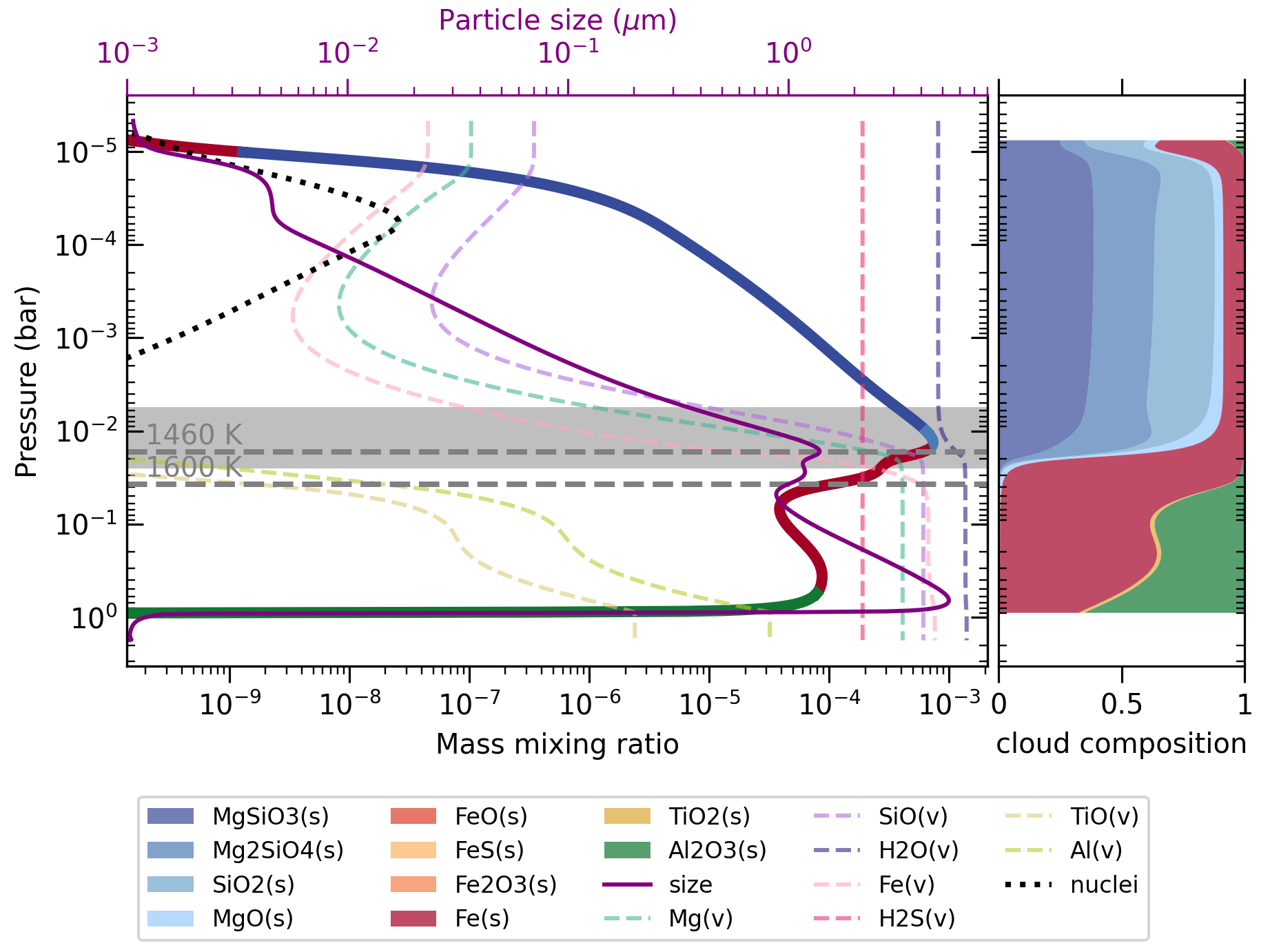Exoplanet's atmosphere contains the information where the planet is formed and how it accretes and evolves. Probing the atmosphere from the molecular lines in the transmission and emission spectrum unveils the chemical composition of the planet. However, an uncertain factor in retrieving exoplanet spectra is the presence of clouds. Clouds affect the transmission and emission spectrum by smearing out molecular features, displaying their own absorption features or inducing temperature inversion. To obtain the composition of the atmosphere from spectrum, forward cloud models are run millions of times, a process called retrieval. This requires the cloud model to run fast, preferentially computed within seconds. Currently many retrieval analyses simply impose clouds, neglecting the fact that clouds form by the condensation of gas species, and ignoring their connection to the composition of the exoplanet atmosphere gas.
Recently, a cloud model tailored to retrieval studies of exoplanet spectroscopic retrieval, have been developed by a team led by Helong Huang, a PhD student in the Department of Astronomy, Tsinghua University. The new cloud model, named ExoLyn, considers the simultaneous condensation of multiple species onto a cloud particle and follows the vertical diffusive and settling motions of particles in the atmosphere. Given the planet temperature and bulk composition, ExoLyn computes the cloud particles’ composition and sizes at every layer in the atmosphere and studies how the formation of clouds affect the concentration of vapor species.

Clouds in an atmosphere of a hot Jupiter planet. The thick line in the left panel shows the total cloud mass mixing ratio down the atmosphere. The color represents the dominant species. The colored dashed line, dotted line, and purple lines shows the vapor, nuclei concentration, and the particle size, respectively. The clouds are optically thick below 0.01 bar, as shown by the gray region. The right panel presents the composition of the cloud particles at each height.
ExoLyn has been most thoroughly tested on hot Jupiters, a type of exoplanet having Jupiter size and mass, but orbiting closer around their host stars. The temperature on these planets is so high that silicates and iron evaporated deep in the atmosphere and condense in higher layers, forming silicate clouds on the top of iron layer. For a hot Jupiter with solar abundance, the team found that silicate clouds are composed of a mixture of magnesium-silicates, e.g., MgSiO3, Mg2SiO4 and SiO2, while a metal-rich hot Jupiter tends to form SiO2 clouds. These characteristics of clouds generated by ExoLyn agree with more complex models, but only cost the computational time of 2 seconds. The silicate components in the clouds contribute to additional absorption at specific wavelengths, like MgSiO3 at 10 micron and SiO2 at 8 and 12 micron. As a result, ExoLyn can contribute to the interpretation of JWST spectra and enlighten us about what kind of clouds form on the exoplanets. Aside from hot Jupiters, ExoLyn can be applied to other types of planets, like self-luminous planets and sub-Neptunes, by selecting different condensation reactions. On sub-Neptune planets, NaCl and KCl clouds form, and can reproduce a flat near-infrared transmission spectrum, as observed on GJ1214 b.

Transmission spectra of hot Jupiters with different compositions. The cloudy and clear hot Jupiters are contrasted by the dark and light color lines. For the solar abundance case (black line), there is an absorption feature at 10 micron, due to the formation of silicate clouds. The 10 times solar metallicity planet (blue line) shows additional absorption features at 8 and 12 um, corresponding to SiO2 clouds forming in the upper atmosphere. For a hot Jupiter with C/O=0.9 (red line), the transmission spectrum becomes flat due to the absorption of light by Fe particles in the upper atmosphere.
The code ExoLyn is open-sourced on Github: https://github.com/helonghuangastro/exolyn. ExoLyn opens the possibility to jointly model the gas component and solid component on the exoplanet atmosphere, empowering more reliable retrieval of cloud composition in exoplanet atmospheres. In the future, it will shed light on the formation mechanism and habitability of exoplanets.
The new work was published in Astronomy & Astrophysics. Helong Huang is the first and corresponding author. Other co-authors include Prof. Chris Ormel of Tsinghua University, and Michiel Min from the Netherlands Institute for Space Research (SRON).
The work of the Tsinghua team was supported by the Natural Science Foundation of China.
Paper Link: https://arxiv.org/abs/2409.18181


